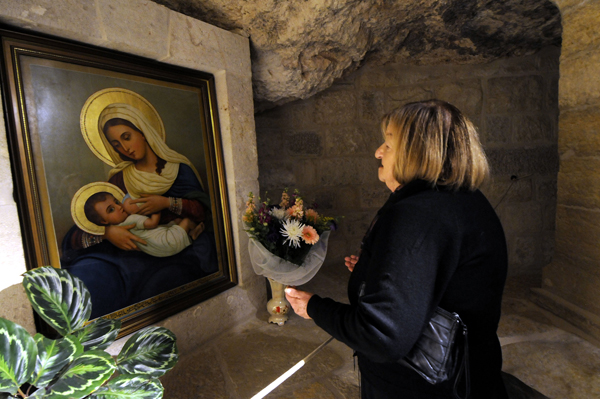BETHLEHEM, West Bank (RNS) Dozens of photos of smiling babies accompanied by moving testimonials line the walls of Franciscan Brother Lawrence Bode’s office in the Milk Grotto Church where, tradition holds, the Virgin Mary hid in an underground cave in order to breast-feed Jesus as she and Joseph were fleeing King Herod.

Hilda Berkley of Bethlehem, West Bank, prays at a painting of Mary breast-feeding the infant Jesus at the Milk Grotto chapel in Bethlehem. The Milk Grotto is believed to be where Mary breast-fed the baby Jesus. RNS photo courtesy Debbie Hill/Catholic News Service.
It was here, Catholics believe, that drops of Mary’s breast milk spilled to the ground while she was nursing Jesus and turned the grotto’s red-brown stones a creamy white.
Located around the corner from the Church of the Nativity, which was built atop the site where Mary gave birth to Jesus, the Milk Grotto is the go-to destination for Christians — and those struggling with infertility.
- READ: Christmas’ missing icon: Mary breast-feeding Jesus (RNS)
“We estimate that in the past dozen years at least 3,000 babies have been born to mothers who prayed in the grotto,” said Bode, who has been the church’s guardian for the past 18 years. “And these are only the births we know about since I started collecting testimonials. We’ve had stories of Muslim women who’ve had children after visiting the grotto, and of two Israeli women as well.”
In all, Bode has seven large photo albums brimming with pictures and testimonials, a handful of which he shares with the tens of thousands of people who visit the church every year.
The Franciscan believes Mary may have left the Nativity church out of a desperate need for privacy.
“She gave birth in a stable, with animals all around, and people had to feed and clean after the animals,” Bode said. “How could Mary have had the privacy to be a mother and nurse in a stable?”
The New York native advises couples grappling with infertility to pray the daily devotion, or prayer, to “Our Lady of the Milk” and to add a pinch of the limestone powder made from the grotto’s stones into a drink before consuming it.
(Bode emphasized that, due to church policy, he cannot respond to letters or send the Milk Grotto powder to those who request it. It is, however, available to pilgrims at $2 a packet.)
The devotion, which Bode believes dates back nearly 2,000 years, implores Mary to intercede with God on their behalf.
He attributes the grotto’s apparent baby boom, as well as about 20 testimonies of other types of healing, to “faith and prayer.” Those who choose to consume the powder do so “because it helps them feel closer to Mary the mother of God,” the brown-robed guardian said as he walked down the stone steps leading into the grotto (there is also a ramp), where Christians have prayed for nearly 2,000 years.
The present stone church and monastery were built by the Franciscans in 1838 and, like other Catholic holy sites, are maintained by the Franciscan Custody of the Holy Land.
The grotto, whose roof dips and rises in various places, houses an altar, an icon of Mary nursing, as well as a 176-year-old sanctuary. Soft lighting, some of it from candlelight, illuminates the many depictions of Mary and the baby Jesus placed there.
Seven years ago the Custody of the Holy Land completed a massive refurbishment of the grotto and chapel. Today, the grotto’s walls and ceiling are nearly white, “something that is remarkable because all the other grottoes discovered in the Bethlehem area are red and brown,” Bode said.
For those who prayed in the grotto prior to its cleaning, the transformation from a dark cave to a luminous cavern evokes the transformation Mary’s milk is said to have wrought.
Bode said his church has represented hope even during the darkest times of war and uprising.
Now 69, Bode said his job is sometimes “difficult,” but that being in Bethlehem and the administrator of a site so connected to the holy family gives him joy, especially at Christmastime.
“This is where the Christian faith began and grew,” he said. “In Bethlehem everywhere you go you feel the spirit of Christmas. This is where the Christian faith began and where it grew. Thousands and thousands come here.”
There is, however, one man who has sworn to never pray in the Milk Grotto Church ever again.
Pointing to a photo of quadruplets, Bode smiled as he related how the babies’ parents brought them to the church.
“The father thanked me but said, ‘I certainly won’t be praying here again.'”
YS/AMB END CHABIN




